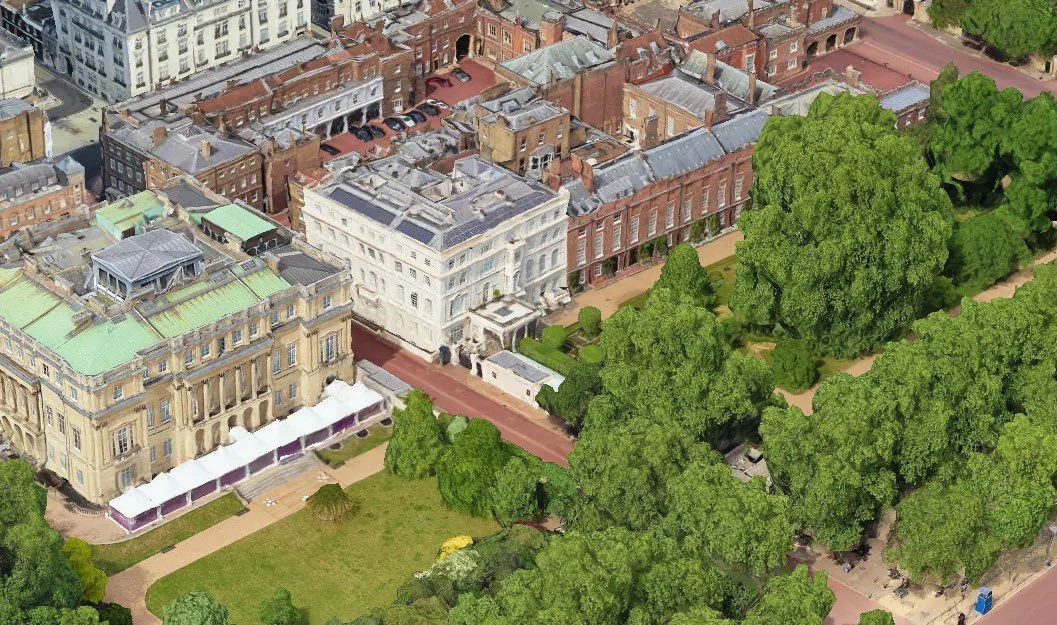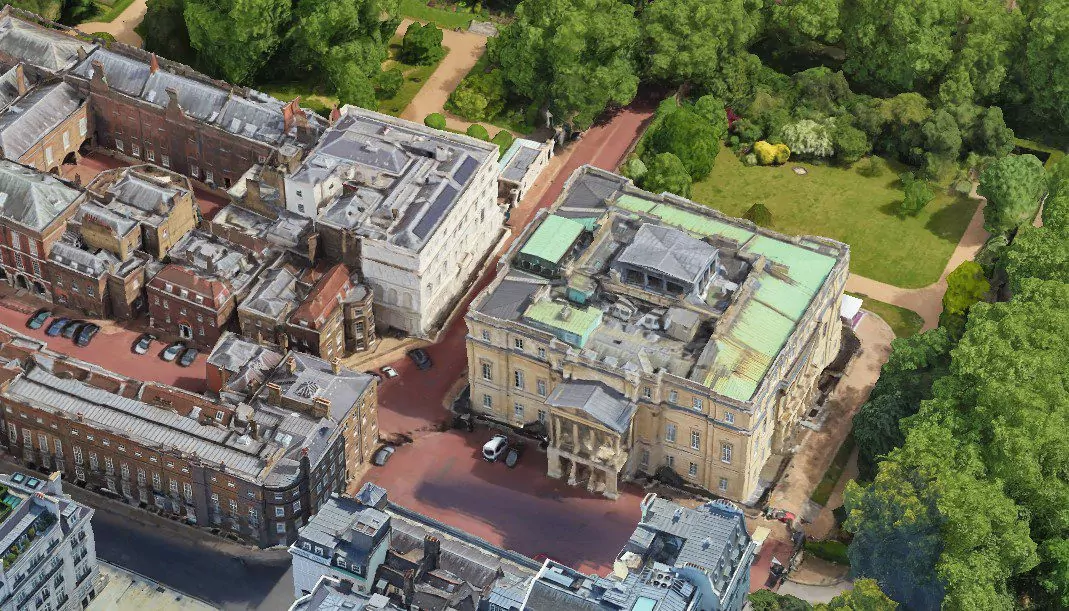Nestled in the heart of Westminster, Clarence House stands as a testament to the rich history and enduring legacy of the British royal family. Constructed in the early 19th century, this illustrious residence has housed some of the most prominent figures in British royalty. Today, it serves as the official London home of King Charles III and Queen Camilla. The house not only reflects centuries of architectural evolution but also provides a glimpse into the personal tastes and lives of its royal occupants. As an interior designer with a keen eye for historical preservation and modern elegance, I’ve found Clarence House to be a fascinating blend of tradition and contemporary style.
King Charles III’s London House
- 📍 Location: The Mall, London, UK
- 🌳 Size of Land: Approximately 0.5 acres
- 🏠 Size of House: Approximately 40,000 square feet
- 💰 Estimated Price: £57.7 million ($72 million)
- 🕰️ Year Built/Remodel: Built between 1825-1827; remodelled extensively in 2003
- 🛏️ Rooms: 5 principal rooms used for official purposes
Table of Contents
- King Charles III’s London House
- Historical Background
- Architectural and Design Elements
- Interior Design: A Deep Dive
- Lancaster Room
- Morning Room
- Garden Room
- Antique and Art Collections
- Current Use and Public Access
- Notable Events and Anecdotes
- The Controversial History of Clarence House
- Cultural and Historical Significance
- FAQ
- Conclusion

Historical Background
Clarence House was built between 1825 and 1827, designed by the renowned architect John Nash. Originally intended for Prince William Henry, Duke of Clarence, who later became King William IV, the house was designed to reflect the grandeur and elegance befitting a royal residence. Nash’s architectural vision brought to life a home that was both stately and inviting, a characteristic that has been preserved through successive renovations.
The early years of Clarence House saw a variety of notable residents, including King William IV and Queen Adelaide. The house underwent several adaptations to suit the needs of its occupants, each leaving a unique mark on its history. These changes were not just structural but also involved significant updates to the interior décor, reflecting the evolving tastes and requirements of the royal family.

From 1953 until her death in 2002, Queen Elizabeth The Queen Mother made Clarence House her home. Her influence on the house’s design and ambiance was profound. She filled the rooms with a rich collection of artworks and antiques, creating a warm and welcoming atmosphere. Her tenure at Clarence House is fondly remembered as a period of elegance and charm, with many of her personal touches still visible today.

In 2003, King Charles III inherited Clarence House. Upon moving in, he initiated a series of refurbishments to modernize the residence while preserving its historical essence. The renovations included new color schemes, updated textiles, and additions from the Royal Collection and his own personal art collection. These updates have seamlessly blended the traditional with the contemporary, creating a home that is both reflective of its storied past and suited to modern living.
Architectural and Design Elements
John Nash’s architectural style is evident in the grand design of Clarence House. The building showcases the classical elegance typical of Nash’s work, with a harmonious balance of form and function. Key structural features include a stately façade, expansive rooms with high ceilings, and large windows that flood the interiors with natural light. The layout of the house is both practical and luxurious, designed to accommodate the royal family’s needs for both private living and official functions.

The exterior of Clarence House is as impressive as its interior. The façade, with its neoclassical design, exudes a timeless elegance. The surrounding gardens, meticulously maintained, offer a serene retreat in the midst of bustling London. King Charles III has played a significant role in the design and maintenance of the gardens, reflecting his passion for nature and sustainability. The gardens include a variety of plants and flowers, some of which were personally selected by the King, adding a personal touch to the landscape.
Interior Design: A Deep Dive
Lancaster Room

The Lancaster Room at Clarence House is a stunning example of historical preservation meeting modern elegance. This room, with its central fireplace and views of the garden shared with St James’s Palace, offers a glimpse into the grandeur of royal living. The decor is a mix of trinkets, antiques, and books from around the world, arranged meticulously to reflect a sophisticated yet inviting atmosphere. Notable features include three large cabinets filled with hardback books on art, history, and geography. The room retains much of its historical ambiance, with walls now painted in a calmer cream to enhance its warm, welcoming feel.
Morning Room

The Morning Room is perhaps the most personal space within Clarence House, decorated in cool hues of blue. This room houses a significant art collection featuring works by John Piper, Graham Sutherland, WS Sickert, and Augustus John. It’s filled with personal photographs, including family portraits and notable moments in the lives of the royal family. The furnishings include a mid-century ornamental pedestal, a 1773 Chippendale sofa, and a matching chair. A be-hatted portrait of King George V and a portrait of George Bernard Shaw by Augustus John flank the windows, adding a historical dimension to the room. This room serves as a reception space for notable guests and the setting for official portraits, such as those from Prince George’s christening.
Garden Room

The Garden Room is uniquely significant, created by merging two rooms that were used by Princess Margaret. It features expansive views of the manicured gardens, providing a serene backdrop. Among its treasures is a 17th-century tapestry gifted to Queen Victoria by Emperor Napoleon III, known as “The Massacre of the Mamelukes.” The room is adorned with personal and historical artifacts, including a heavy wood desk used by the Duke of Cornwall, laden with books like “Our Future: Consumerism or Humanism” by JC Kapur and HRH Sultan Nazrin Shah’s “Reflections and Recollections.” The Garden Room, with its rich decor and historical significance, reflects the deep heritage and personal tastes of its royal inhabitants.
Antique and Art Collections

Clarence House boasts an impressive collection of artworks and antiques that span centuries. The Lancaster Room and Morning Room, in particular, showcase this rich heritage. Items such as the mid-century pedestal, the 1773 Chippendale sofa, and the numerous portraits and artworks by renowned artists provide a deep connection to the past.
| Artwork/Antique | Artist/Origin | Room Location | Historical Significance |
|---|---|---|---|
| Tapestry “The Massacre of the Mamelukes” | Gift from Napoleon III | Garden Room | Gifted to Queen Victoria, 17th-century piece |
| Portrait of King George V | Augustus John | Morning Room | Adds historical depth, depicts royal lineage |
| Chippendale Sofa | Thomas Chippendale | Morning Room | Mid-18th century, reflects royal tastes in furniture |
| Portrait of Queen Elizabeth The Queen Mother | Unknown | Various rooms | Personal legacy, connects to past royal occupancy |
Queen Elizabeth The Queen Mother‘s influence is still strongly felt throughout Clarence House. Her collection of artworks and antiques forms the backbone of the house’s decor. Her keen eye for art and historical pieces has left a lasting legacy, with many of her chosen items still prominently displayed. This includes family portraits, period furniture, and various trinkets that add a touch of personal history to the residence.
Current Use and Public Access
Clarence House plays a pivotal role as the official London residence of King Charles III and Queen Camilla. It is not only a home but also a venue for numerous official events and receptions. The grand rooms and opulent decor provide a stunning backdrop for state occasions, diplomatic gatherings, and charity events hosted by the royal family. These functions highlight the house’s dual purpose of serving as both a private residence and a public space for official duties.
Clarence House also houses the office space for the Prince of Wales’s Household, supporting the monarch’s official engagements. This includes coordinating with over 350 organizations and managing the extensive correspondence and scheduling involved in royal duties. The integration of office space within a historic residence underscores the blend of tradition and modern functionality that defines Clarence House.

Clarence House opens its doors to the public during the month of August, providing a rare glimpse into the royal residence. Visitors can tour several rooms on the ground floor, including the Lancaster Room, the Morning Room, and the Garden Room. These tours offer insights into the daily life of the royal family and the historical significance of the residence. Key highlights include the grand chandeliers, antique furnishings, and personal photographs on display, which add a personal touch to the visitor experience.
Visitors to Clarence House can expect a meticulously curated experience that showcases the home’s historical and personal elements. The tour guides provide detailed explanations of the house’s history, architecture, and the significance of the items on display. Notable rooms open for viewing include:
| Highlight | Description | Room/Area | Special Features |
|---|---|---|---|
| Lancaster Room Tour | Visitors see the grand design and decor | Lancaster Room | Central fireplace, views of the garden |
| Art Collection Display | Exhibits significant artworks | Morning Room | Works by John Piper, Graham Sutherland, WS Sickert, Augustus John |
| Garden Views | Scenic views of the manicured garden | Garden Room | Formal area designed by King Charles III |
| Personal Memorabilia | Display of personal photos and memorabilia | Various Rooms | Photographs, antiques, and artworks reflecting royal family history |
These tours allow visitors to step into the lives of the royal family, offering a rare opportunity to see how the royals live and work in one of London’s most prestigious residences.
Notable Events and Anecdotes
Clarence House has been the site of many significant events in British royal history. It has hosted state banquets, diplomatic receptions, and various royal family celebrations. These events have cemented its place as a central hub of royal activity. One memorable event was the celebration of Queen Elizabeth The Queen Mother’s 100th birthday in 2000, which brought together the royal family and dignitaries from around the world.
| Event | Date | Description | Notable Figures Involved |
|---|---|---|---|
| Queen Elizabeth The Queen Mother’s 100th Birthday | 2000 | Celebratory event with dignitaries and royal family | Queen Elizabeth The Queen Mother, various royals |
| Prince George’s Christening Portraits | 2013 | Official portraits taken in the Morning Room | Prince George, Duke and Duchess of Cambridge |
| State Banquets and Receptions | Various | Hosted numerous state functions and receptions | Various international dignitaries and royals |
| Public Tours Initiation | Annually in August | Opening Clarence House for public tours | Royal Household, public visitors |
Anecdotes from the royal family’s time at Clarence House add a personal dimension to its history. For instance, King Charles III often reflects on his fond memories of growing up in the house, where he and his siblings enjoyed a relatively private childhood away from the public eye. The Queen Mother was known for her warmth and hospitality, often inviting friends and family for intimate gatherings, creating a home filled with love and laughter.
The Controversial History of Clarence House

Clarence House, the elegant London residence of King Charles III and Queen Camilla, once faced the threat of demolition. During World War II, the house suffered extensive damage from bombings, leading to discussions about its potential destruction. However, due to its historical significance and the efforts of dedicated restorers, Clarence House was meticulously rebuilt and preserved. Today, it stands as a testament to the resilience and rich heritage of the British monarchy. This near loss only adds to the fascination and allure of this iconic royal home.
Cultural and Historical Significance
Clarence House symbolizes continuity and tradition within the British monarchy. As a residence that has housed multiple generations of royals, it represents the enduring legacy of the royal family. The home’s preservation and ongoing use for official functions underscore its importance as a living part of British history.

Clarence House has been featured in numerous media outlets, from documentaries to news articles, highlighting its significance and the public’s fascination with royal life. This coverage has contributed to the house’s iconic status and the public’s enduring interest in the British monarchy. The residence’s elegant decor and historical artifacts are often showcased, drawing attention to its cultural and historical value.
FAQ
Where does King Charles III live now?
King Charles III currently resides at Clarence House in London. He has lived there for the past 20 years, continuing to use it as his primary residence even after ascending to the throne. Despite the traditional expectation to move to Buckingham Palace, King Charles has chosen to remain at Clarence House due to personal preferences and the logistical challenges of moving.
What is the address of the property?
Clarence House is located on The Mall in London’s City of Westminster, just a short distance from St James’s Palace and Buckingham Palace. The precise address is Clarence House, The Mall, London SW1A 1BA, United Kingdom.
How much is Clarence House worth?
Clarence House is estimated to be worth approximately £57.7 million ($72 million). This valuation considers its prime location in Westminster, its historical significance, and the extensive renovations it has undergone over the years.
Is Clarence House open to the public?
Yes, Clarence House is open to the public during the month of August. Visitors can tour several rooms on the ground floor, including the Lancaster Room, the Morning Room, and the Garden Room. These tours offer a unique glimpse into the royal residence and its historical and personal artifacts.
Who owns Clarence House?
Clarence House is owned by the Crown Estate, which means it belongs to the reigning monarch by virtue of their accession to the throne. It is not a private property of King Charles III, and therefore cannot be sold by him. The Crown Estate is managed by an independent organization, with surplus revenue benefiting the Treasury.
Conclusion
Clarence House remains a vital part of the British royal family’s heritage. Its historical significance, architectural beauty, and ongoing role as a royal residence make it an enduring symbol of the monarchy’s continuity and tradition. As King Charles III and Queen Camilla continue to reside and host official functions here, Clarence House will undoubtedly remain a cherished part of royal history for years to come. The blend of historical preservation and modern updates ensures that this iconic residence continues to captivate and inspire both visitors and royal enthusiasts alike.

